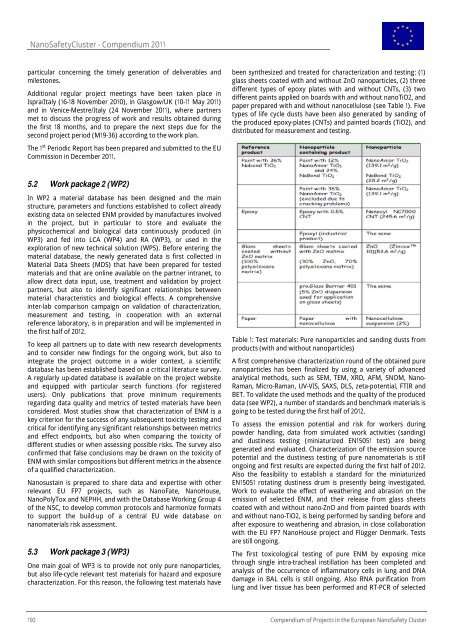Timing, hosts and locations of (grouped) events of NanoImpactNet
Timing, hosts and locations of (grouped) events of NanoImpactNet
Timing, hosts and locations of (grouped) events of NanoImpactNet
Create successful ePaper yourself
Turn your PDF publications into a flip-book with our unique Google optimized e-Paper software.
NanoSafetyCluster - Compendium 2011<br />
particular concerning the timely generation <strong>of</strong> deliverables <strong>and</strong><br />
milestones.<br />
Additional regular project meetings have been taken place in<br />
Ispra/Italy (16-18 November 2010), in Glasgow/UK (10-11 May 2011)<br />
<strong>and</strong> in Venice-Mestre/Italy (24 November 2011), where partners<br />
met to discuss the progress <strong>of</strong> work <strong>and</strong> results obtained during<br />
the first 18 months, <strong>and</strong> to prepare the next steps due for the<br />
second project period (M19-36) according to the work plan.<br />
The 1 st Periodic Report has been prepared <strong>and</strong> submitted to the EU<br />
Commission in December 2011.<br />
5.2 Work package 2 (WP2)<br />
In WP2 a material database has been designed <strong>and</strong> the main<br />
structure, parameters <strong>and</strong> functions established to collect already<br />
existing data on selected ENM provided by manufactures involved<br />
in the project, but in particular to store <strong>and</strong> evaluate the<br />
physicochemical <strong>and</strong> biological data continuously produced (in<br />
WP3) <strong>and</strong> fed into LCA (WP4) <strong>and</strong> RA (WP3), or used in the<br />
exploration <strong>of</strong> new technical solution (WP5). Before entering the<br />
material database, the newly generated data is first collected in<br />
Material Data Sheets (MDS) that have been prepared for tested<br />
materials <strong>and</strong> that are online available on the partner intranet, to<br />
allow direct data input, use, treatment <strong>and</strong> validation by project<br />
partners, but also to identify significant relationships between<br />
material characteristics <strong>and</strong> biological effects. A comprehensive<br />
inter-lab comparison campaign on validation <strong>of</strong> characterization,<br />
measurement <strong>and</strong> testing, in cooperation with an external<br />
reference laboratory, is in preparation <strong>and</strong> will be implemented in<br />
the first half <strong>of</strong> 2012.<br />
To keep all partners up to date with new research developments<br />
<strong>and</strong> to consider new findings for the ongoing work, but also to<br />
integrate the project outcome in a wider context, a scientific<br />
database has been established based on a critical literature survey.<br />
A regularly up-dated database is available on the project website<br />
<strong>and</strong> equipped with particular search functions (for registered<br />
users). Only publications that prove minimum requirements<br />
regarding data quality <strong>and</strong> metrics <strong>of</strong> tested materials have been<br />
considered. Most studies show that characterization <strong>of</strong> ENM is a<br />
key criterion for the success <strong>of</strong> any subsequent toxicity testing <strong>and</strong><br />
critical for identifying any significant relationships between metrics<br />
<strong>and</strong> effect endpoints, but also when comparing the toxicity <strong>of</strong><br />
different studies or when assessing possible risks. The survey also<br />
confirmed that false conclusions may be drawn on the toxicity <strong>of</strong><br />
ENM with similar compositions but different metrics in the absence<br />
<strong>of</strong> a qualified characterization.<br />
Nanosustain is prepared to share data <strong>and</strong> expertise with other<br />
relevant EU FP7 projects, such as NanoFate, NanoHouse,<br />
NanoPolyTox <strong>and</strong> NEPHH, <strong>and</strong> with the Database Working Group 4<br />
<strong>of</strong> the NSC, to develop common protocols <strong>and</strong> harmonize formats<br />
to support the build-up <strong>of</strong> a central EU wide database on<br />
nanomaterials risk assessment.<br />
5.3 Work package 3 (WP3)<br />
One main goal <strong>of</strong> WP3 is to provide not only pure nanoparticles,<br />
but also life-cycle relevant test materials for hazard <strong>and</strong> exposure<br />
characterization. For this reason, the following test materials have<br />
been synthesized <strong>and</strong> treated for characterization <strong>and</strong> testing: (1)<br />
glass sheets coated with <strong>and</strong> without ZnO nanoparticles, (2) three<br />
different types <strong>of</strong> epoxy plates with <strong>and</strong> without CNTs, (3) two<br />
different paints applied on boards with <strong>and</strong> without nanoTiO2, <strong>and</strong><br />
paper prepared with <strong>and</strong> without nanocellulose (see Table 1). Five<br />
types <strong>of</strong> life cycle dusts have been also generated by s<strong>and</strong>ing <strong>of</strong><br />
the produced epoxy-plates (CNTs) <strong>and</strong> painted boards (TiO2), <strong>and</strong><br />
distributed for measurement <strong>and</strong> testing.<br />
Table 1: Test materials: Pure nanoparticles <strong>and</strong> s<strong>and</strong>ing dusts from<br />
products (with <strong>and</strong> without nanoparticles)<br />
A first comprehensive characterization round <strong>of</strong> the obtained pure<br />
nanoparticles has been finalized by using a variety <strong>of</strong> advanced<br />
analytical methods, such as SEM, TEM, XRD, AFM, SNOM, Nano-<br />
Raman, Micro-Raman, UV-VIS, SAXS, DLS, zeta-potential, FTIR <strong>and</strong><br />
BET. To validate the used methods <strong>and</strong> the quality <strong>of</strong> the produced<br />
data (see WP2), a number <strong>of</strong> st<strong>and</strong>ards <strong>and</strong> benchmark materials is<br />
going to be tested during the first half <strong>of</strong> 2012.<br />
To assess the emission potential <strong>and</strong> risk for workers during<br />
powder h<strong>and</strong>ling, data from simulated work activities (s<strong>and</strong>ing)<br />
<strong>and</strong> dustiness testing (miniaturized EN15051 test) are being<br />
generated <strong>and</strong> evaluated. Characterization <strong>of</strong> the emission source<br />
potential <strong>and</strong> the dustiness testing <strong>of</strong> pure nanomaterials is still<br />
ongoing <strong>and</strong> first results are expected during the first half <strong>of</strong> 2012.<br />
Also the feasibility to establish a st<strong>and</strong>ard for the miniaturized<br />
EN15051 rotating dustiness drum is presently being investigated.<br />
Work to evaluate the effect <strong>of</strong> weathering <strong>and</strong> abrasion on the<br />
emission <strong>of</strong> selected ENM, <strong>and</strong> their release from glass sheets<br />
coated with <strong>and</strong> without nano-ZnO <strong>and</strong> from painted boards with<br />
<strong>and</strong> without nano-TiO2, is being performed by s<strong>and</strong>ing before <strong>and</strong><br />
after exposure to weathering <strong>and</strong> abrasion, in close collaboration<br />
with the EU FP7 NanoHouse project <strong>and</strong> Flügger Denmark. Tests<br />
are still ongoing.<br />
The first toxicological testing <strong>of</strong> pure ENM by exposing mice<br />
through single intra-tracheal instillation has been completed <strong>and</strong><br />
analysis <strong>of</strong> the occurrence <strong>of</strong> inflammatory cells in lung <strong>and</strong> DNA<br />
damage in BAL cells is still ongoing. Also RNA purification from<br />
lung <strong>and</strong> liver tissue has been performed <strong>and</strong> RT-PCR <strong>of</strong> selected<br />
192 Compendium <strong>of</strong> Projects in the European NanoSafety Cluster






